In America, it would be difficult to find someone who has never heard of the Big Bang theory. It is taught in science classes throughout the country. Though many scientists have dedicated their lives to the study of this theory, the Big Bang is best classified as science-fiction, rather than science.
science: systematic knowledge of the physical world gained through observation and experimentation
(See "science" Random House Dictionary, Random House Inc, 2010; See also The American Heritage Science Dictionary, Houghton Mifflin Company, 2010)
However, this claim of evolution only applying after life gets started is exactly that: a claim. Many textbooks teach something else entirely:
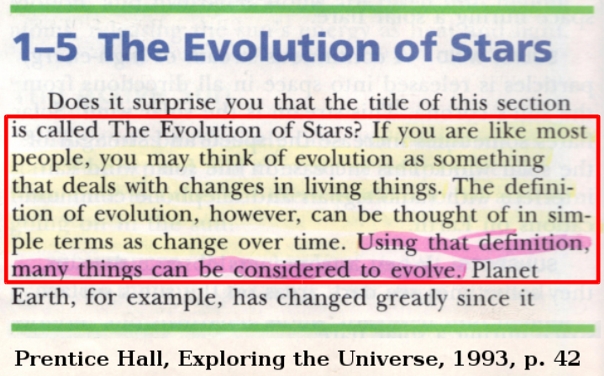
The Big Bang theory was first thought of in 1927 by a Belgian scientist named George Lemaitre. Later, in 1948, a model was made by
(See Isaac Asimov, Asimov's New Guide to Science, 1984, p. 43; See also Vance Ferrell, The Evolution Cruncher, 2001, p. 69; See also Andre Berger, The Big Bang and Georges Lemaitre: Proceedings of a Symposium in Honour of G. Lemaitre Fifty Years After His Initiation of Big-Bang Cosmology, D. Reidel Pub Co, 1984, ISBN: 9789027718488)
Fred Hoyle accidentally coined today's well-known phrase of "Big Bang," intending to belittle it over the radio, but it picked up momentum by those who desperately needed an exaplantion for the universe that did not include an intelligent designer.
(See "Big Bang Astronomer Dies," BBC News, Aug 22, 2001, [http://news.bbc.co.uk/2/hi/uk_news/1503721.stm])
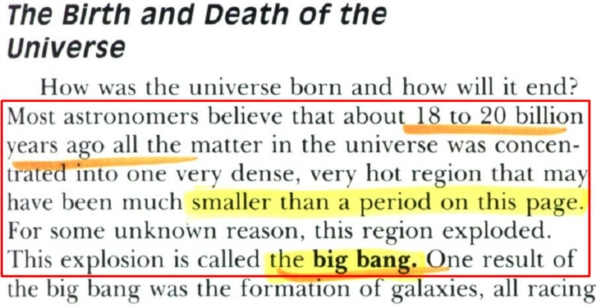
The textbooks teach that 18-20 billion years ago, all the matter in the universe was compacted into a tiny dot smaller than the period at the end of this sentence. The Big Bang is a name given to the explosion of that dot. Immediately, any thinking individual would have obvious questions like: Where did the matter come from? Where did the energy come from? What caused this explosion? When I say God created the universe, I am immediately asked where God comes from, but when I ask an evolutionist where the dirt came from for the Big Bang, it's as if they expect everyone to accept it without answering the question.
Those who liked the Big Bang idea knew that there had to be some sort of credible evidence to get people to believe it, and the grandest evidence for the Big Bang theory today is called "Red Shift." To understand the Red Shift theory, we first must understand the doppler effect.
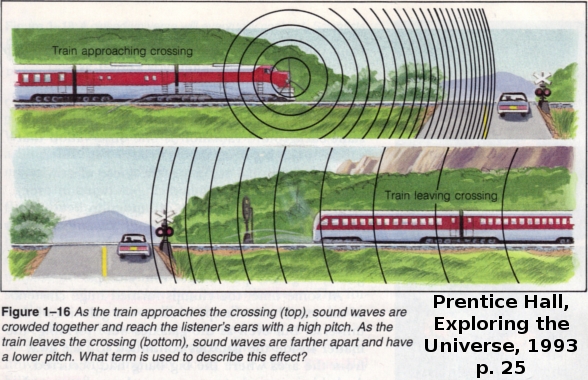
| Sound comes from the source to your ear in waves at a certain speed. If the source of the sound is moving towards you, then the sound waves will be compressed and the sound you hear will be higher pitch. If the source of the sound is moving away from you, then the sound waves will be rarfracted, causing a lower pitch. |
"Atoms of different gases have different atomic structures. Therefore they have different internal staircases -- they gain and lose energy in different amounts and produce light of different colors...A star's color corresponds to its surface temperature. "
-Pat Murphy & Paul Doherty, "The Color of Nature," Chronicle Books, 1996, p. 59, ISBN: 9780811813570
Wait a second, I thought the red color was supposed to indicate a star moving away from us, but now the red color indicates what gas its burning? Which one is it, and how can they verify either of them when no one has ever even seen a star to know what it is? The Red Shift theory says that if a star is moving towards us, it shows us a compressed color (blue), and if it is moving away, it shows us a rarfracted color (red), but how do they know that isn't just the color of the gas?
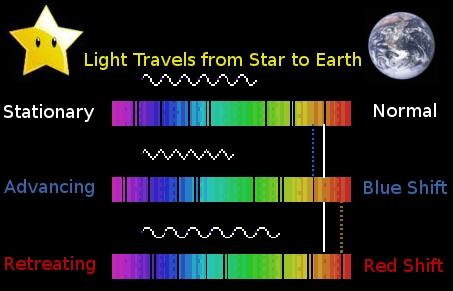
Star light is
Even light in general, what it is and how it works, has never been fully understood. For example, in 1906, J.J. Thompson was awarded the Nobel Prize for proving electrons were particles. In 1937, his son was awarded the Nobel Prize for proving electrons were waves. Today, some are calling them photons. Are they waves, particles, photons, all, or neither? Even giving it one of those names does not explain what it is, and though there are certainly some interesting theories, no one knows for sure.
After
In 1999, experiments were done at Harvard, Smithsonian, and Cambridge to slow light down using a specially treated cesium gas. The first
(See David Whitehouse, science editor, Beam Smashes Light Barrier, BBC News, July 19, 2000; See also William J. Cromie, Physicists Slow Speed of Light, Harvard University Gazette, Feb 18, 1999; See also Malcolm W. Browne, Researchers Slow Speed of Light to the Pace of a Sunday Driver, New York Times, Feb 18, 1999)
Since the constant speed of light has been disproven, that means all measurements based on light and distance cannot be determined to be accurate without claiming absolute knowledge of the universe. Red Shift
In spite of the major assumptions made, and the evidence against it, Red Shift is still taught as scientific fact, without discussing any of the huge flaws in the theory:

The Big Bang is reliante on speculative evidence such as Red Shift because it would be impossible for anyone to provide real scientific evidence for the origin of time, space, and matter. To discuss something's origin, we must go beyond time, space, and matter, which takes us outside the realm of science.
(See Evolutionism: A New Age Religion for more details)
The speed of light has also been shown to be declining slowly over time.
(See Barry Setterfield & Trevor Norman, The Atomic Constants, Light, and Time, Aug, 1897, prepared for senior research physicist Lambert T. Dolphin; For chart, see CEN Technical Journal, June, 2000)

The complete chart shows 164 experiments recorded on the speed of light over the past 300 years. The chart above is a piece that shows all the recorded experiments from 1880-1980. In the past, a steady decline in the speed of light has been observed.
Though it has been declining in the past, notice that it levels off between 1950-1960, and remains constant from that point forward. What would have happened in the 1950s to cause the speed of light to stop declining?
In 1953, the first atomic clock was setup, which measures the wavelength of a cesium 133 atom. (it became the "official" standard by 1967) That means they're using light to measure light, and it creates a rubber ruler problem. If you use light to measure the speed of light, you'll never notice the decrease.

In 1955, the National Physical Laboratory in England built the first cesium-beam clock used as a calibration source. Over the next few years, these atomic clocks were setup worldwide, and that explains why we have not seen a decline in the speed of light since 1955.
Prior to the atomic clock change, the second was measured by planetary orbit. If we compare the orbital-second with the atomic-second over time, the two start to differ in that the atomic-second appears to be slower. If atomic clocks are "correct," the orbital speeds of Mercury, Venus, and Mars are increasing, which is impossible based on the laws of conservation of energy. (i.e. first law of thermodynamics)
(See Alan Montgomery & Lambert Dolphin, "Is the Velocity of Light Constant in Time?" Gallilean Electrodynamics, Vol 4, No. 5, 1993)
Again, evolutionists need a constant speed of light in order for their billions-of-years idea to work, since all calculations in astronomy rely on a constant speed of light. It is for this reason that the evidence of light being slowed down, and speeded up, are quickly brushed under the rug during debate, and some evolutionists will flat out deny the existance of such experiments in a desperate attempt to hang on to their religious beliefs in the Big Bang.
(See Creation/Evolution Debate -- Dr. Kent Hovind, PhD in education, head of Creation Science Evangelism, vs Dr. Robert Trivers, Evolutionist Professor of Anthropology and Biological Sciences at Rutgers University, April 1, 2003, during Q&A about light, Rutgers University, New Brunswick, NJ)
The bottom line: They look at a star and see it's red, and therefore conclude that the universe has been expanding over billions of years from a dot. If you are gambling your eternity on a such a wild concept, I would highly advise against it. Remember, the word "universe" is literally translated from the latin as "a single spoken sentence."
(See 'uni' & 'verse', Online Etymology Dictionary [www.etymonline.com], Douglas Harper, 2001-2010)
And God said, Let there be light: and there was light.
-Genesis 1:3
First, it must be stated that no one knows what a star is for certain. It is theorized that stars are like our sun, and that our sun is a star, but no one knows for sure if this is true. It is a reasonable theory, but to say "we know what stars are," assumes knowledge that we don't have.
"Stars are so far away that they appear to us to be just pinpoints of light. We cannot see their size or shape. So how can we tell different types of stars apart? For the vast majority of stars,there is only one characteristic feature that we can observe – the color of their light. "
-Stephen Hawking, A Brief History of Time, Ch. 3, 1988, ISBN 0-553-38016-8
"Even when viewed through the largest telescopes, allstars remain tiny pinpoints of light and simply cannot be magnified in size as plantets can."
-Dr. Donald B. DeYoung, Astronomy and the Bible, 2nd Edition, published Baker Books, 2005, p. 66, ISBN: 0-8010-6225-X
|
To calculate the unknown distance of an object, we use trigonometry. Two surveyers, knowing two angles and a side, can calculate the unknown distance and complete the triangle.
To find the unknown distance to the stars, a base of the triangle is needed, but because the stars are so far away, a very large base needed. Originally, the diameter of the earth (8,000 miles) was used. However, it was not a large enough base for something at such a great distance. Today, earth's orbit around the sun is used for the triangle base, angle is measured in June and again in December; this method is called parallax trigonometry. |
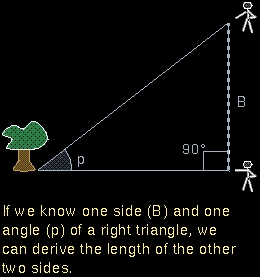 |
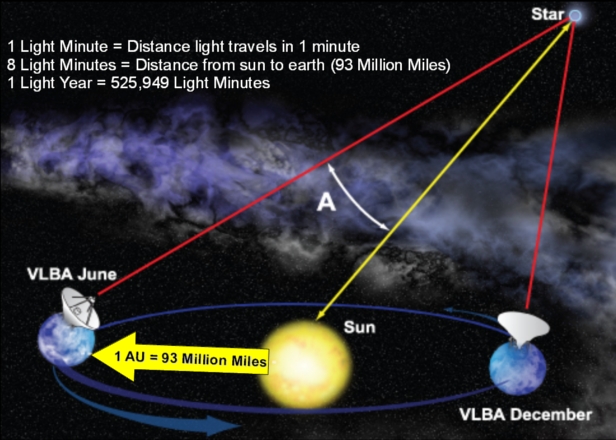
Remember, a
This may sound a little confusing, but let's look at a more simplified example to show how
Since a light-minute is a distance, let's convert light-minutes to inches. The time the light from the sun takes to get to earth is about 8 light-minutes (also known as AU - Astronomical Unit). Since they measure on both sides of earth's orbit, we need two AU, which is 16 light-minutes. We will convert 16 light-minutes into 16 inches.
One light-year has about 525,949 light-minutes, so we would be surveying an object about 526,000 inches away.
If we were going to measure 100 light years, we would have two surveyers standing 16 inches apart on top of the Sear's Tower in Chicago, looking at a dot on the Empire State Building in New York City. That forms an angle of 0.00017 degrees. With such a tiny base to the triangle, we do not have much ability to measure those great distances.

What's really ludicrous about this is that evolutionists are claiming astronomers have been able to measure the distance to stars BILLIONS of light years away. I'll give the astronomers 100 light years to be fair, but it's currently impossible, from our tiny vantage point in the universe, to measure billions of light years. The stars could very well be billions of light years away, and it may be a reasonable theory to hold, but that's not something we know.
Four points to consider:
|
Evolutionists are claiming the earth is billions of years old because they think that stars evolved billions of light years away, and therefore, the light from the stars needs billions of years to travel to earth. This is
It is he that sitteth upon the circle of the earth, and the inhabitants thereof are as grasshoppers; that stretcheth out the heavens as a curtain, and spreadeth them out as a tent to dwell in:
-Isaiah 40:22
The existance of the spin of planets and galaxies would logically force any scientific mind to say the dot itself, from before the Big Bang, had to be spinning. This is the same concept on how some textbooks teach star formation in the same way:
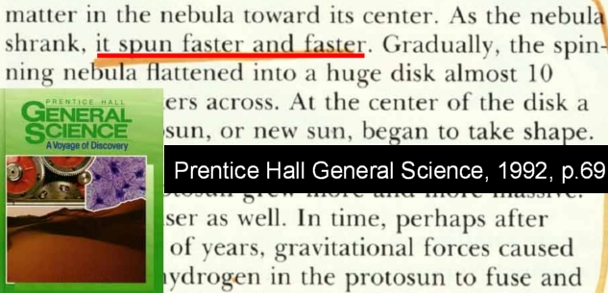
The Law of Conservation of Angular Momentum then becomes a problem for evolutionists and the Big Bang. For example, if an object (like a merry-go-round) is spinning clockwise, anything that is thrown from it will be spinning clockwise, until it meets resistance.

Some evolutionists claim that something struck these planets and caused their rotation to shift. Perhaps in imagination that might work, but in reality the impact of something that would change the rotation of a planet would near destroy the planet. At the very least, we should see enourmous catastrophic damage on the planet to indicate that claim, yet we do not find evidence for it.
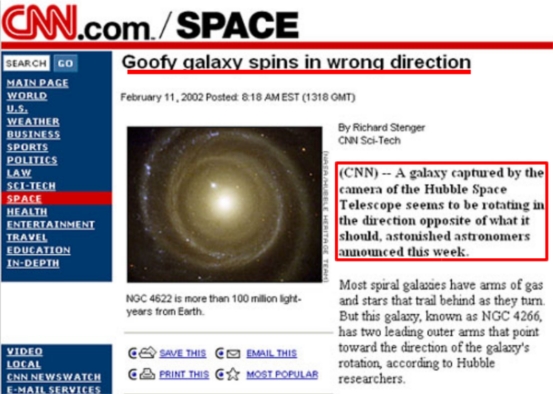
This phenomenon is unexplainable in naturalistic, scientific terms, and all evidence indicates there must have been a Creator to the order in the universe.
Granite is a type of rock that can be found all over the world, but it is not known how granite forms. For example, igneous rock is formed from volcanic activity, and sedimentary rock is formed from water mixing sediments, but granite is still unknown. It is said that granite is part of the igneous family because the earth had to cool over millions of years, but this

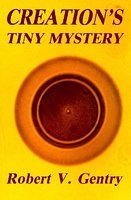 |
Dr. Robert Gentry did research on the disposal of radioactive wastes at Oakridge Laboratories in Knoxville, TN. In his research of testing granite, he made the discovery of polonium halos in the rock, and published in many major science journals (e.g. Science, Annual Review of Nuclear Science, Nature, Physics Today, etc).
(See Halos.com for more details)
Uranium decays to polonium. Polonium then decays to lead. The half-life of polonium is very short. Depending on the isotope, the decay of polonium could range from 100 years, to a few minutes. (See The Carbon Dating Game for more details on half-life) |
|
A good analogy of polonium in molten lava would be like dropping an alka-seltzer into water. Alka-seltzer does not last very long in water, and is gone within minutes.
If you dropped alka-seltzer into water, and put it in the freezer to slowly cool down, the water would freeze long after the bubbles had disappeared. However, if you were able to instantaneously freeze the water, the bubbles would be trapped inside. From a flat surface, the bubbles would appear to be rings, or halos. |
 |
An explosion is three-deminsional, though it appears to us to be two-deminsional. Each polonium breakdown is like a tiny explosion. Although the actual shockwave is a bubble, from a flat (or 2D) surface, it appears to be a halo.


The real mystery to this comes with the lack of uranium rings. The only known way for us to obtain polonium, is to decay it from uranium. A normal uranium decay will have uranium rings on the outside, then polonium rings on the inside. However, there are no uranium rings in the granite. How do you get pure polonium and trap it in rock instantly?
And God said, Let the waters under the heaven be gathered together unto one place, and let the dry land appear: and it was so.
-Genesis 1:9
A "standard candle" (also known as a 'cepheid variable') is claimed by evolutionists to be the method by which they've measured millions and billions of light years. They look at a star in the night sky, and see one is brighter than the others. They observe the brightness of that star, and
A major problem with this theory is using the "hubble constant" to measure the distance to standard candles. In 1995, some astronomers started measuring the age of the universe by the hubble constant. The first standard candle was named when they were trying to find the distance to the spiral galaxy M96. However, very wild numbers can be drawn from the hubble telescope."You have to be careful about [drawing conclusions] because all of the [Hubble Constant] measurements have huge systematic errors." |
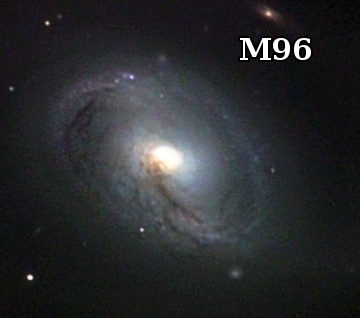 |
Evolutionists will claim they're basing their calculations on the hubble "constant," but it's not a constant at all. The hubble is always moving, so it's not a constant. Also, when they pull back a variety of numbers, it leaves evolutionists open to choose which numbers they like that best supports their bias. This whole process of selecting measurements is quite similar to how they select dates with radiometric dating; they pick what they want based on their preconceived conclusion.
(See The Carbon Dating Game for more details)
"Yet another set of observations indicates that the universe--as described by a popular cosmological model--appears to be younger than its oldest stars. The new study puts the age of the cosmos at 8.4 billion to 10.6 billion years, younger than the 13 billion to 16 billion years estimated for elderly stars."
-Ron Cowen, "Further Evidence of a Youthful Universe," Science News, Sept. 9, 1995, p. 166
Just because something appears to be a certain way, doesn't make it fact. A mirage appears to be a real object, but upon further investigation, it isn't there. They don't know the distance to stars, but insist that they do for the sake of attempting to validate the Big Bang model, which was created from pure imagination.
Basically, an evolutionist, who believes in the Big Bang, sees a slightly brighter star and then
 |
"We now know that faintness arises from two causes [distance and absorbing matter in space] and -James Jean, "The Universe Around Us," New York: Cambridge University Press, 1969, p. 61 Here's a simplistic way to understand absorbing matter in space: if you get a flashlight and shine it through ice or a plastic tarp, from your vantage point, it would be at normal brightness, but to an observer on the other side of the object, the flashlight would appear to be dim. Does that mean the flashlight is miles away? No, it's quite close, but the light is not as strong when traveling through absorbing matter. |
To see a bright star and conclude it to be closer is
Dark matter is an evolutionary attempt to explain some unexplainable phenomena in the universe. For example, if matter and energy exploded from a Big Bang, then it should be evenly distributed throughout the universe. However, it is not. We find huge clumps of star cluster, then huge distances of empty space, then another huge clump of stars. The evolutionary explanation for the missing matter is dark matter.
Yet, the religious belief in invisible matter is the excuse used to explain other problems for the evolutionists. For example, why do the planets in our solar system appear perfectly smooth, when that is not the way they would naturally form in a Big Bang model? Evolutionists say the invisible matter has effect on gravity causing the smoothness of the planets.

Let's say we were having lunch together, and you ordered a piece of cake. You got up to use the restroom, and I ate your cake before you returned, but you did not know this. You come back, sit down, and ask me what happened to your cake. I say, "
Ultimately, the universe had a beginning, and the earth is here. So that means: Either someone made this world, or the world made itself. Either "In the beginning, God..." or "In the beginning, nothing exploded..."
It requires enourmous amounts of creative imagination and mental gymnastics to make up a story about the universe evolving from nothing. I would highly recommend not waging your eternity on a swiss cheese theory that spits in the face of God's basic laws of science and physics.
O Timothy, keep that which is committed to thy trust, avoiding profane and vain babblings, and oppositions of science falsely so called:
-1 Timothy 6:20
But the day of the Lord will come as a thief in the night; in the which the heavens shall pass away with a great noise [that's a big bang], and the elements shall melt with fervent heat, the earth also and the works that are therein shall be burned up.
2 Peter 3:10













![There is No Saving Grace Without Repentance [creationliberty.com]](../images/store13a.jpg)
![Wolves in Costume: Kent Hovind [creationliberty.com]](../images/store11a.jpg)
![Corruptions of Christianity: Seventh-day Adventism [creationliberty.com]](../images/store09a.png)
![501c3: The Devil's Church [creationliberty.com]](../images/store07a.jpg)
![Feminism: Castrating America [creationliberty.com]](../images/store04a.jpg)







![Why Millions of Believers on Jesus Are Going to Hell [creationliberty.com]](images/store05a.jpg)
![Corruptions of Christianity: Catholicism [creationliberty.com]](http://www.creationliberty.com/images/store14a.jpg)
![False Prophet Profiles: Kim Clement [creationliberty.com]](http://www.creationliberty.com/images/store12a.jpg)
![Christmas: Rejecting Jesus [creationliberty.com]](http://www.creationliberty.com/images/store10a.jpg)
![Christian Music: For The Love of Money [creationliberty.com]](images/store08a.png)
![Psychology: Hoodwinked by the Devil [creationliberty.com]](images/store06a.jpg)
